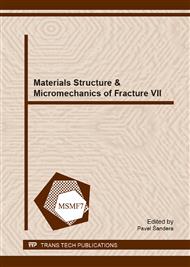p.753
p.757
p.761
p.765
p.769
p.773
p.777
p.781
p.785
The Effect of Temperature on the Course of Refractory Castables Cracking
Abstract:
Factors determining the durability of a material include among others its thermal shock resistance, as a non-homogenous temperature field may trigger the formation and propagation of cracks. To evaluate thermal shock resistance by means of one of the resistance criteria: the Rst or R4 parameter, it is necessary to know the work of fracture (γWOF), which is determined in a cracking test. Technical testing conditions influence the recording of crack propagation in a material sample. Ordinary and refractory castables are a group of materials in which the effect of temperature on the course of their cracking is among others related to the presence of deformations, internal stresses and cracks. Tests were performed for mullite, andalusite and boxite doped chromia castables, having known phase compositions, for which the temperature of liquid phase appearance in the matrix was calculated. A considerable increase in the value of castables γWOF at 900°C was noted compared to the values at 300°C and 600°C. In the group of the examined castables the highest γWOF value was obtained for andalusite castable. The applied methods of testing enabled simultaneous presentation of crack propagation in terms of energy (load vs. deformation) and kinetics (load vs. time).
Info:
Periodical:
Pages:
769-772
Citation:
Online since:
November 2013
Authors:
Keywords:
Price:
Сopyright:
© 2014 Trans Tech Publications Ltd. All Rights Reserved
Share:
Citation:


